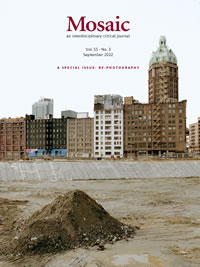Issue 55.3
Overview

Special Issue: Re-photography
Published: September 2022
View the issue introduction or see the issue summary and contents below.
12 essays, totalling 242 pages
$24.95 CAD
A reprinting of the best writing on photography Mosaic has published, Re-Photography also features the photography and writing of Roy Arden.
RuptureRoy Arden A reproduction of Roy Arden’s Rupture. | |
Notes on Archive WorksRoy Arden Canadian artist Roy Arden reflects on his photography. | |
When it All Suddenly Clicked: Deconstruction after Psychoanalysis after PhotographyMichael Naas In this essay, I argue that several of Derrida’s central motifs—from supplementarity to différance—can best be understood today in the light of the radical rethinking of time offered by psychoanalysis and, especially, by photography. It is as if, I will argue, the fundamental rations of deconstruction “itself” could come to light only in a time that was not contemporaneous with itself through the supplement of psychoanalysis and the technical inventions of photography. In other words, it took time for it all suddenly to click. | |
Shudder Speed: The Photograph as Ecstasy and TragedyDavid Farrell Krell Aristotle, Augustine, and Heidegger describe the phenomenon of “suddenness.” Interpreters of Greek tragedy such as Hölderlin and Jacob Bernays relate suddenness to the cathartic effect of tragedy—violent agitation of the psyche followed by a restoration of calm. Does shutter speed in photography produce a similar effect? | |
The Surplus Value of ImagesW.J.T. Mitchell This essay analyzes the ways in which images are over- and under-estimated, from idols that signify the highest values and demand human sacrifice, to empty signs that are worthless, hollow illusions. It then shows how these disparate estimations of “the surplus value of images” lead to the perception of images as living agencies that play crucial roles in social conflicts. | |
Ghost in the Machine: Photographs of Specters in the Nineteenth CenturyPaola Cortés-Rocca “Spirit Photography” consists of photographs in which the sitter appears near to the shadowy image of a dead beloved. This essay examines the ways that this practice both reaffirms the early promise of immortality made by photography and presents the technological catastrophes of the twentieth century. | |
Light Writing: Portraiture in a Post-Traumatic AgeMieke Bal This essay explores the portrait, not as memory of the disappeared, but as both a record and an appeal, both recognition and validation, of subjects who are themselves traumatized. It confronts figurative portraits with works that retain the trace as basis of meaningfulness. | |
Showings Forth: Dubliners, Photography, and the Rejection of RealismEloise Knowlton This essay asks what Dubliners may owe to a realism derived not from literary realism’s models, but from a photographic realism newly emergent as photography moved, during Joyce’s youth, out of the studio and into the street. Employing a distinction from Lyotard’s early work, it claims for late nineteenth-century photography a disruptive figural force that erodes a prior, painterly, discursive order of the photographic, and traces this figurality in Dubliners. | |
‘The Transparent Eyeball’: On Emerson and Walker EvansCaroline Blinder Taking Emerson’s “Nature” as its starting point, this paper argues that in Lincoln Kirstein’s and William Carlos Williams’s readings of Evans as a visionary artist of the vernacular, Emersonian ideals were always part and parcel of the search for an intrinsically American manifesto of photography. | |
The Deepening of Apperception: On Walter Benjamin’s Theory of FilmRodolphe Gasché According to Walter Benjamin, the history of photography is a process of progressive emancipation of reproductive technology from magic and the aura. This process culminates in the art of cinema as a public art in which total transparency is achieved. The essay is an attempt to investigate the changes in perception that come with the new technologies and the progressive evacuation of the sacred and the auratic from art. | |
Flicker 1: Reflections on Photography and Literature in the Works of Hélène CixousMichael Naas Reflections on photography and literature in the works of Hélène Cixous. | |
Flicker 2: Reflections on Cinematography and Literature in the Works of Hélène CixousMichael Naas Reflections on cinematography and literature in the works of Hélène Cixous. |